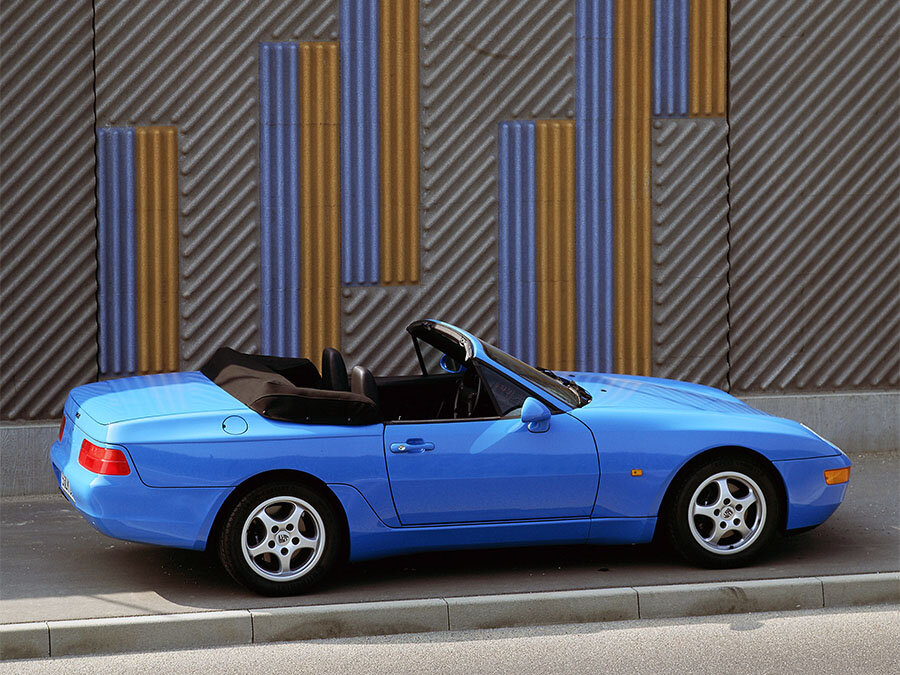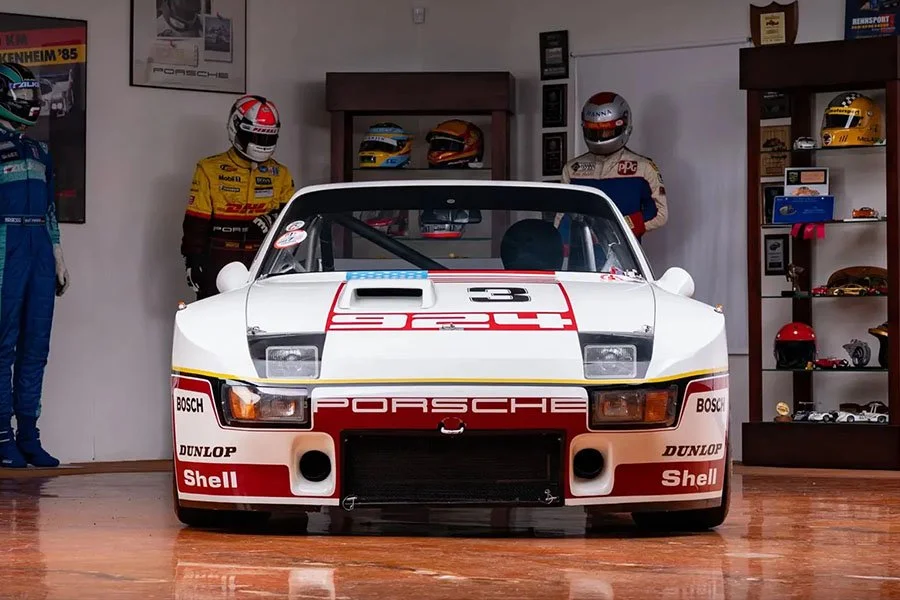Guide: Porsche 968 - a Historical & Technical Appraisal
/BACKGROUND
The 968 was Porsche’s successor to the 944: a front-engined four cylinder 2+2 that had sold in huge numbers between 1981 and 1991.
Subtly re-styled and re-engineered, the 968 was conceived as an interim model until Porsche’s mid-engined Boxster was ready.
However, by the early 1990s, Porsche sales had nose-dived and the German firm was in financial turmoil. As a global recession took hold, the ageing four cylinder transaxle platform (which dated back to 1975) struggled to compete against a new breed of competitively priced Japanese GTs.
Likewise, the 964-based 911 also looked decidedly old hat despite its heavily re-engineered underpinnings; Porsche dealers knew they were in for a tough few years.
Launched in August 1991 for the 1992 model year, the 968 was available in two body styles: a Coupe and a Cabriolet.
CHASSIS
As Porsche could not afford to invest in new chassis tooling for a stop-gap model that had a projected five year lifespan, only limited changes were made to the 944 S2’s steel unibody structure.
Suspension was therefore identical to the outgoing model. MacPherson struts with alloy lower control arms were used at the front and semi trailing arms with torsion bars at the rear.
Sachs dampers were installed at each corner and thicker anti-roll bars at either end.
The 944 S2’s Brembo four-piston calipers, ventilated discs and Bosch ABS were also carried over to the 968. Disc size was 297mm at the front and 300mm at the rear.
Power steering was standard along with new 16-inch five-spoke Cup Design wheels. The rims measured 7-inches wide at the front, 8-inches wide at the rear and could be shod with tyres from Continental, Bridgestone, Goodyear, Toyo or Yokohama.
A 74-litre fuel tank was installed underneath the boot floor.
ENGINE / TRANSMISSION
The 968’s engine was derived from Porsche’s water-cooled, all-alloy, single overhead camshaft inline four cylinder unit found in the 944 S2. However, it was significantly revised to increase power, flatten the torque curve, lower emissions and improve fuel efficiency.
Perhaps most importantly, the 968’s Type M44/43 engine was equipped with a new VarioCam system that varied the timing of the intake valves by adjusting the tension on the timing chain connecting the intake and exhaust camshafts. The result was much improved bottom and mid-range torque.
Other new equipment included a big-bore two-into-one exhaust system, an uprated intake manifold that enabled the engine to rev higher plus forged and lightened pistons and rods. Like the 964, the underside of the pistons was now cooled by an oil spray.
The heavy old torsional vibration damper for the crankshaft was deleted.
Bosch Motronic M2.10 engine management replaced the outgoing L-Jetronic. Compression was increased from 10.9.1 to 11.0:1.
Displacement remained at 2990cc thanks to a bore and stroke of 104mm and 88mm respectively.
Power output rose from 211bhp at 5800rpm to 240bhp at 6200rpm. The torque rating was now 225lb-ft at 4100rpm compared to 206lb-ft at 4000rpm.
In an attempt to modernise its appearance, Porsche equipped the 968 engine with a variety of under-bonnet plastic mouldings.
Two gearbox options were offered: a six-speed manual or four-speed Tiptronic.
Tiptronic was an expensive option that offered a choice of clutchless manual or fully automatic shifting. It had never previously been offered on Porsche’s four cylinder line.
Transmission was via a single-plate Sachs clutch and Torsen differential.
BODYWORK
Cosmetically, the 968 was a re-imagined 944 for the 1990s, albeit within constraints afforded by not adopting major tooling changes.
The front end was made to resemble the 928 with exposed retractable headlights and similar bumper treatment.
The higher wing line needed to accommodate the new headlights meant the drag coefficient increased from 0.33 to 0.34.
Down the flanks, Porsche added new flexible sill mouldings, new door handles and new wing mirrors, all of which were body coloured.
The rear three quarter windows were now bonded in place. Along with the lift-up tailgate, the rear three quarter windows were an immediate giveaway to the 968’s ageing 924 and 944 ancestry.
Arguably the biggest improvements in terms of freshening up the design were the neat polyurethane front and rear panels. The tail fascia was home to modern integrated lights that were also bonded in place.
Cabriolets came with reinforced bodyshells to compensate for the lack of a roof.
INTERIOR
Inside, many fixtures and fittings were carried over from the 944 S2 including the instrument binnacle and dash. A new 300kmh or 180mph speedometer was installed but otherwise, the architecture was practically identical.
Disappointingly, neither full leather nor air-conditioning were standard (although AC was standard on US-market 968s). Instead, the seats were upholstered in cheap leatherette with cloth centres that featured the Porsche motif.
The seats had electric height adjustment only. Electric windows and mirrors came as standard.
All left-hand drive cars were equipped with driver and passenger airbags while right-hand drive 968s initially came with only a driver’s airbag. These cars used a three-spoke sports wheel for the first year of production instead of the bulbous four-spoke airbag wheel.
OPTIONS
Optional extras included the desirable Sport Chassis kit that comprised Koni shock absorbers, lowered ride height, 304mm front brake discs, thicker anti-roll bars and 17-inch Turbo design wheels (7.5-inches wide at the front and 9-inches wide at the rear).
The 17-inch Turbo design wheels could be ordered separately along with a body coloured rear spoiler, limited-slip differential and sunroof.
To enhance the cockpit, buyers could add heated front seats, full leather, half leather or full cloth upholstery, sports seats, air-conditioning, cloth door panels and cruise control. There were also a variety of audio options.
USA VERSION
968’s destined for the USA came with additional rubber bumperettes plus air-conditioning and cruise control as standard. To comply with local regulations, the reverse lights were clear (as they were on Japanese market examples).
WEIGHT / PERFORMANCE
Porsche quoted a weight of 1370kg for the Coupe and 1440kg for the Cabriolet. Both variants were 60kg heavier than their respective 944 S2 predecessors. Tiptronic added a further 60kg.
Top speed was 157mph for the manual Coupe which had a 0-62mph time of 6.5 seconds. By contrast, Tiptronic Coupes had a top speed of 154mph and 0-62mph time of 7.8 seconds. Cabriolet top speeds were slightly slower owing to their messier aerodynamics.
1992 MODEL YEAR
Production started in August 1991 for the 1992 model year but press and public reaction was mixed.
Sales were disappointing; Porsche would have have expected to shift three times the 3260 Coupes and 2093 Cabriolets produced in year one.
1993 MODEL YEAR
Things got even worse for the 1993 model year when just 1871 Coupes and 1045 Cabriolets were built.
The few developments made included passenger airbags for right-hand drive cars and a pollen filter for the air-conditioning unit.
New options included heated seats, 17-inch Cup Design wheels, piping for the front seats and a mobile phone module.
1994 MODEL YEAR
Production figures continued to decline during the 1994 model year when 1076 Coupes and 869 Cabriolets were manufactured.
New options included fully electric seats, reworked soft-spoke 17-inch Cup Design wheels and an updated assortment of stereos.
The Sport Chassis pack now came with stiffer springs and externally adjustable shocks, adjustable spring plates and stabilisers, reinforced suspension bushes and cross-drilled and ventilated brake discs.
968 SPORT
To stimulate demand in the UK, Porsche Cars Great Britain requested a Sport variant that sat between the Club Sport and standard 968 Coupe. It retailed at £3000 more than the Club Sport but £5000 less than the standard Coupe.
The specification was that of the Club Sport but with electric windows and mirrors, central locking, an alarm, cloth comfort seats, rear seats and the electric tailgate release (all normally deleted on the Club Sport).
Because of the extra electrical equipment, the UK Sport came with a standard 968 wiring loom (instead of the simplified Club Sport item).
In total, 306 were completed.
1995 MODEL YEAR
As a result of disappointing sales, Porsche decided to effectively withdraw the 968 from the market one year earlier than expected.
The 1995 model year saw 258 Coupes delivered to the USA along with 366 Cabriolets.
One Euro market Cabriolet was also produced.
Porsche would not produce another front-engined model until the Cayenne SUV arrived in 2002.
Text copyright: Supercar Nostalgia
Photo copyright: Porsche - https://www.porsche.com


































